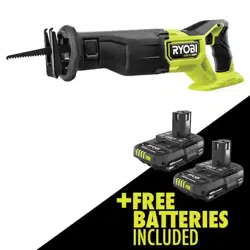Loading ...
Loading ...
Loading ...

6 – English
Depress the latches on each side of the battery pack and
remove the battery pack from the tool.
For complete charging instructions, see the operator’s manual
for your battery pack and charger.
INSTALLING/REMOVING BLADE
See Figure 2, page 8.
To install the blade:
Remove the battery pack.
Lift the blade clamp lock/release lever located on the side
of the saw.
Insert the saw blade between the blade clamp and the
saw bar.
Lower the blade clamp lock/release lever to lock the blade
into place.
To remove the blade:
Remove the battery pack.
Lift the release lever to release the blade from the blade
clamp.
SHOE ASSEMBLY
See Figure 3, page 9.
The shoe assembly of the reciprocating saw pivots up and
down in both directions.
TURNING THE SAW ON/OFF
See Figure 4, page 9.
The lock-off button, located on the handle above the switch
trigger, reduces the possibility of accidental starting.
To turn the saw on: Slide lock-off button to the unlocked
position, and press the switch trigger.
To turn the saw off: Release the switch trigger and return
the lock-off button to the locked position.
CAUTION:
The lock-off button should be in the locked position when
the saw is not in use or is being transported.
GENERAL CUTTING
See Figure 5, page 9.
WARNING:
Make sure the blade does not touch work until motor
reaches full speed, since this could cause loss of control
resulting in serious injury.
Secure the workpiece to a work bench or table with a
vise or with clamps.
Mark the line of cut clearly.
Make sure the saw blade teeth are clean of any debris or
foreign material.
Hold the saw firmly with both hands in front of and clearly
away from you.
Slide the lock-off button to the unlocked position and
depress the switch trigger.
Allow the saw blade to reach full cutting speed.
Set the shoe assembly against the workpiece.
Move the blade into the workpiece.
NOTE: Do not force. Use only enough pressure to keep
the saw cutting. Let the blade and saw do the work. Keep
pressure on the shoe, against the workpiece.
PLUNGE CUTTING
See Figure 6, page 9.
WARNING:
Make sure the blade does not touch work until motor
reaches full speed, since this could cause loss of control
resulting in serious injury.
WARNING:
Blades longer than 6 in. can whip and should not be used
for plunge cutting. Failure to heed this warning can result
in serious personal injury.
Choose a convenient starting point inside the cutting area
and place the tip of the blade over that point.
Rest the front edge of the shoe assembly on the workpiece
and hold the saw firmly with both hands in position during
the cut.
Slide the lock-off button to the unlocked position and
depress the switch trigger.
Allow the saw blade to reach full cutting speed.
Tilt the saw downward until the tip of the blade starts
cutting the workpiece.
Allow the blade to penetrate the workpiece.
Tilt the saw until the blade is perpendicular to the
workpiece.
WARNING:
Cutting into electrical wiring can cause the blade, the
blade clamp, and the saw bar assembly to become elec-
trically live. Do not touch metal parts when cutting into a
wall; grasp only the insulated surfaces on the tool. Make
sure hidden electrical wiring, water pipes, and mechanical
hazards are not in the blade path when cutting into a wall.
METAL CUTTING
See Figure 7, page 9.
You may cut metals such as sheet steel, pipe, steel rods,
aluminum, brass, and copper with the saw.
Observe the following tips when metal cutting:
Be careful not to twist or bend the saw blade.
Do not force the tool and use a slow speed.
Use cutting oil when cutting soft metals and steel. Cutting
oil also keeps the blades cool, increases cutting action,
and prolongs blade life.
OPERATION
Loading ...
Loading ...
Loading ...
